I’ve always been interested in flags. Fascinated in how they embody identity, nationality, pride, a sense of belonging. People can love them, hate them and even die for them.
I like to collect the flags of the numerous countries that I’ve visited. Here are a few and their origins and symbolisms…
|
Australia
The Australian flag has a dark royal blue base with a depiction of the British Union Jack in the upper left quarter. It has a large white seven pointed star (the star of federation) under the middle of the Union Jack. The right half depicts the Southern Cross constellation, 1 small white five pointed star and 4 larger equal sized white seven pointed stars. The Union Jack reflects Australia’s colonial links to Britain. Queen Elizabeth II is Australia’s head of state. The seven pointed Star of Federation represents each of Australia’s six states, one additional point represents Australia’s territories. The Southern Cross is a constellation of stars that can be seen from all of Australia’s states and territories. The Australian national flag was first flown in 1901 after Australia had become a nation. Interesting Factoids : |
 |
|
Austria
The Austrian flag consists of three equal horizontal strips. The top and bottom stripes are red and the middle stripe is white. Legend has it that Duke Leopold V. of Austria (1157-1194) was involved in a battle during the Crusades, and after the fight his white battledress was soaked in blood. When he removed his belt, though, the cloth underneath was still white. That very sight is said to have inspired the red, white and red stripes on the Austrian flag. The Austrian flag originates from 1230 when Duke Friedrich II (1210-1246) wanted Austria to become more independent of the Roman Empire at which time he and adopted the red-white-red flag. The current version of the Austrian flag was adopted on April 27, 1984. Intersting Factoid : |
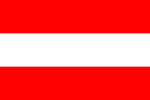 |
|
Belgium
The Belgian flag consists of three equal sized vertical stripes. Left to right : black; yellow; red. The colours of the Belgian flag are based on the coat of arms of the province of Brabant. The vertical stripe design being based on the design of France’s flag. The present day Belgian flag was adopted on Jan. 23, 1831 after Belgium gained independence from the Netherlands in 1830. During a revolution in 1789 the Belgian flag appeared with the same colors, but was designed with the stripes running horizontal. Interesting Factoid : |
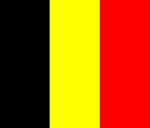 |
|
Denmark
The Danish flag consists of a red base with an uneven white cross. The horizontal stripe of the cross runs across the centre of the flag, but the vertical stripe is shifted to the left side of the flag. The white cross on the Danish flag represents Christianity. The cross design of the Danish flag was also adopted by the other Nordic countries: Sweden, Norway, Finland and Iceland. The flag was adopted in 1625 and is generally considered the oldest continuously used national flag in the world. Legend has it that the Danish flag fell from the skies on June 15, 1219, the day in which King Waldemar II defeated the Estonians in battle. Historians, though, think the Danish flag was derived from old crusader banners of the time. Intersting Factoid : |
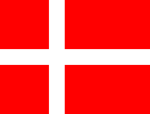 |
|
France
The French flag consists of three equal vertical stripes. From left to right : blue; e white; and red. The French flag was adopted in May 1794. After Napoleon’s defeat at Waterloo the French flag was put out of use, however it was reintroduced in 1830 and has remained in use ever since. Intersting Factoid : |
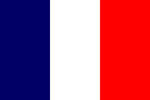 |
|
Germany
The German flag consists of three equal horizontal stripes. From top to bottom : black; red; and gold. The colors black, red and gold have been associated with Germany since the middle ages, but the current German flag colors are traced back to early 19th century volunteers, who fought for the country in the Napoleonic wars. The colors are based on the soldiers’ uniforms which were black coats with red braid and gold buttons. The current German flag was adopted on May 9, 1949. The German flag has actually been used at least three times in German history. It was adopted in 1848 and was abolished in 1852. It was then readopted as the flag of the Weimar Republic on August 11, 1919, and again abolished on March 12 1933, when it was replaced by the flag of the Third Reich. The German flag was also used by the German Democratic Republic (East Germany) until 1959, but added a coat of arms to. Germany was partitioned into two countries following the Second World War and reunited on October 3, 1990, and this flag was chosen. Intersting Factoids : |
 |
|
Hong Kong
The Hong Kong flag features a white, stylised, five-petal Hong Kong orchid tree (Bauhinia blakeana) flower in the centre of a red field. Up until 1 July 1997 Hong Kong was a British Colony. In July 1997 it was officially handed back to China and this flag was first officially hoisted, in that handover ceremony marking the transfer of sovereignty. The design of the flag carries cultural, political, and regional meanings. The colour itself is significant; red is a festive colour for the Chinese people, used to convey a sense of celebration and nationalism. Moreover, the red colour is identical to that used in the national PRC (peoples Republic of China) flag, chosen to signify the link re-established between post-colonial Hong Kong and China. The position of red and white on the flag symbolizes the “one country two systems” political principle applied to the region. The stylized rendering of the Bauhinia blakeana flower, a flower discovered in Hong Kong, is meant to serve as a harmonizing symbol for this dichotomy. |
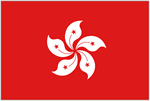 |
|
Netherlands
The flag of the Netherlands consists of three equal sized horizontal stripes. From top to bottom : red; white; and blue. The red stripe which was originally orange. This colour along along with the white and blue stripes, are based on the heraldic colors (coat of arms) of Prince William of Orange, who led the fight for Dutch independence against Spanish rule in 1568. The flag is nicknamed the ‘Prince’s Flag’. The orange-white-blue flag first appeared around the early 1570s. In the early to mid-17th century, the orange stripe was changed to red but the reason is unclear. One theory is because red is more visible than orange when viewed from a distance. Red, white and blue were officially announced as the colors of the flag in 1796. The flag was banned for a short period at the turn of the 19th century after France occupied the Netherlands. The Netherlands was again independent in 1813 and the flag was reinstated. Intersting Factoid : |
 |
|
New Zealand
The New Zealand flag consists of a dark blue base with a British Union Jack in the upper left quarter. On the right side of the flag are four, five-point red stars outlined in white that represent a southern cross. The Union Jack represents New Zealand’s British Commonwealth heritage. The Blue background symbolizes the sea and sky. The four stars symbolizing the constellation ‘the Southern Cross’, represent the stars Alpha, Beta, Gamma and Delta. The Southern Cross is a prominent constellation in the southern hemisphere, and represents New Zealand’s geographical position to the rest of the world. The New Zealand flag was adopted on June 12, 1902 but the flag was actually introduced in 1869. New Zealand gained independence from Britain on September 26, 1907. Until 1865, New Zealand used the British Union Jack as its flag. In 1867 a flag similar to the current one was introduced with the letters NZ on it. The letters were then replaced by the four stars in 1869. Interesting Factoids : |
 |
|
Norfolk Island
The Norfolk Island Flag consists of three vertical bands. From left to right they are: Green; White and Green, respectively. The middle white band is slightly wider than the other two green bands. In the center of the white band there is the motif of the Norfolk Island Pine Tree. The official flag of Norfolk Island was adopted on 17th January, 1980 to represent the territory of Norfolk. The green pine tree in the centre of the flag is native to the Norfolk Island. The green stripes in the Norfolk Island Flag stand for the rich vegetation found on the island. |
 |
|
Norway
The Norwegian flag has a red background with a blue ‘Scandinavian cross’ on it. The Scandinavian cross is outlined by white stripes. The vertical stripe of the cross isn’t centered; instead it’s based on the left side of the flag. The colours of the Norwegian flag are believed to have been influenced by the flags of France, the United States and Britain and are considered the colors of liberty and independence. The cross is common to most Scandinavian flags, and represents Norway’s link to the other Scandinavian countries. The Norwegian flag was first adopted on July 17, 1821 and is based on the Danish flag, with a blue cross placed within the white cross of the Danish flag. Intersting Factoid : |
 |
|
Singapore
The flag of Singapore consists of two equal-sized horizontal stripes: red on top and white on the bottom. On the left hand side of the red stripe there is a white crescent moon with five white, five-pointed stars to its right. The red represents universal brotherhood and equality of man and the white stands for purity and virtue. The crescent moon, symbolizes the young nation of Singapore on the rise and the five stars represent the country’s ideals of democracy, peace, progress, justice and equality. The Singapore flag was adopted on December 3, 1959 when it gained independence from being a British colony Intersting Factoids : |
 |
|
Sweden
The flag of Sweden consists of a blue base with a yellow Scandinavian cross. The vertical stripe of the cross is off center. The design of the Swedish flag is likely based on the flag of Denmark; while the yellow and blue originate from the Swedish Coat of Arms which features three yellow crowns on a blue base. The cross, common to most Scandinavian flags, represents Sweden’s link to other the Scandinavian countries. The exact age of the Swedish Flag is unclear, but the oldest recorded images of a blue cloth with a yellow cross on it date back to the 16th century. The Swedish flag was officially readopted on June 22, 1906, making it one of the oldest flags in the world. Intersting Factoid : |
 |
|
Thailand
The Thai flag consists of five horizontal stripes. The top and bottom are equal-sized red stripes, the middle stripe is blue which is lined above and below by equal-sized white stripes. The blue stripe is double the size of the other four. The red stripes represent the blood spilt to maintain Thailand’s independence. The white stands for purity and is the color of Buddhism which is the country’s main religion. Blue is Thailand’s national colour and it represents the Thai monarchy. The blue is also used to honor Thailand’s World War I allies, Great Britain, France, United States and Russia, who all had red, white and blue flags. The current Thai flag was adopted on September 28, 1917, making it one of the world’s older flags. Intersting Factoid : |
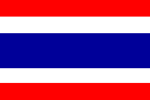 |





